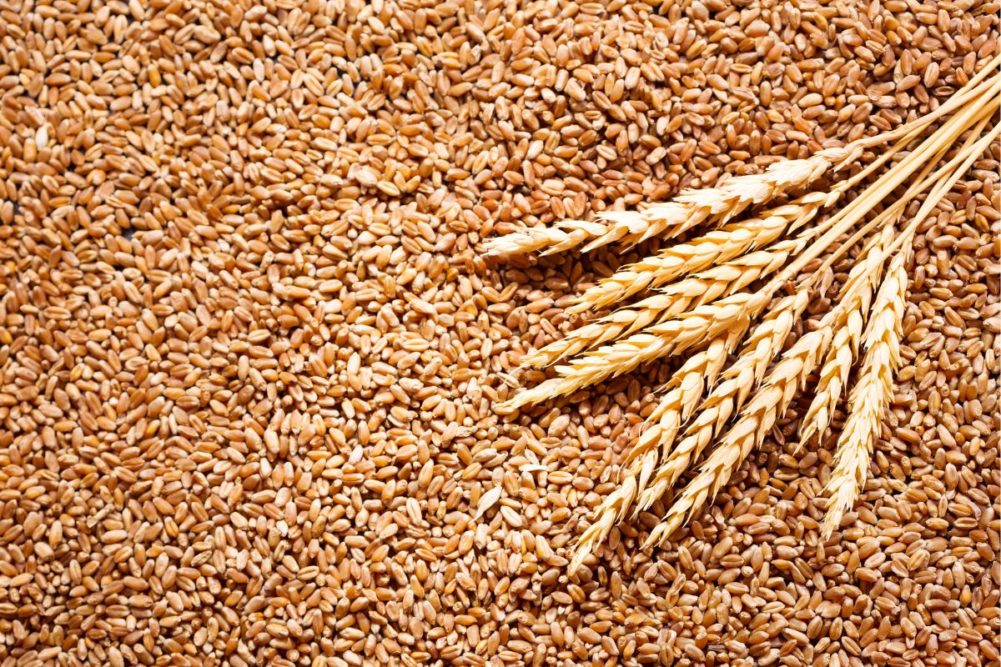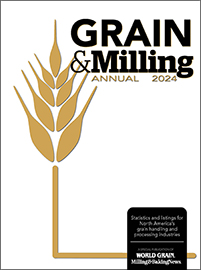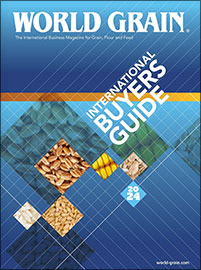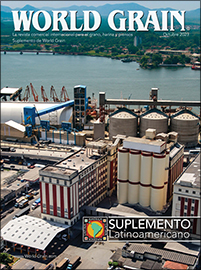KANSAS CITY, MISSOURI, US — A measure of performance for the transformation of raw or dirty wheat purchased to produce a unit of flour sold often is referred to as extraction rate or dirty wheat yield. It is the measured units of wheat required to produce a measured unit of straight grade or total flour produced and sold. The units of measure include commercial bushels of dirty or raw wheat to produce a hundredweight (100 pounds) of straight grade flour (bushels of wheat/cwt flour) or alternatively tonnes of raw or dirty wheat needed to produce a tonne of straight grade flour.
The quantity of wheat and its value identifies wheat cost per unit of product sold and delivered to the customer. It is assumed that mill byproduct generated will be equal to the difference between the wheat and flour weight and has a value in the market. The cost of wheat less the byproduct credit reflects the cost of goods sold or material cost whether in bulk or packaged as specified by the customer.
Knowing the cost of goods, the mill owner must establish a gross margin based on estimated run time and efficiencies. Gross margin considers the cost of the transformation process, which includes direct variable manufacturing costs such as electricity, labor, packaging, etc., as well as fixed costs that incur independent of mill operation such as loan retirement (principal and interest), insurance, etc. The gross margin also includes gross profit sufficient to cover management expenses and taxes while providing return to the mill owner(s) as net profit.
 Credit: ©JEFF GWIRTZ
Credit: ©JEFF GWIRTZ A simplified mill budget example for pricing is shown in Figure 1.
Considerable effort goes into establishing a flour sales price based on the knowledge or estimate of dirty wheat yield. As extraction rates improve over time and milling margins grow ever smaller, an understanding of flour extraction and its management become even more critical. An article from the January 2018 issue of World Grain identifies extraction improvements over time in the US market as well as reasons for the improvements, including both agronomic practices, machinery improvement and shifts in consumer preference.
The improvements identified are not isolated to the United States but have affected the global wheat industry, perhaps to varying degree. It is important to understand that not all countries’ milling industries have control over wheat purchase decisions and maybe even flour pricing, making understanding operational monitoring of the wheat transformation process even more critical in ensuring milling business continuity.
Dirty wheat yield data is affected by many functional centers in the milling operations site as shown in Figure 2. The performance of any wheat purchase can be dramatically influenced by both technical and economic decisions at each functional center as product — either feed or flour — is delivered to the customer.
Flour extraction can be based on several bases, including dirty wheat to the mill, wheat to first break, total products from the milling operation, all wheat in and all milled product out. Some of these bases have utility in monitoring performance in milling site functional areas while others convolute functional area performance issues.
In this article, we will consider how dirty wheat yield or extraction impacts cost of goods in the primary functional centers within the milling process, including cleaning, tempering and milling. We will identify control points for millers managing the transformation process and remind upper management of critical details that must be considered when using dirty wheat yield or extraction values.
Wheat cleaning
The milling center holds little in-process storage. Often scales or flow balances are not considered for monitoring milling center system performance but rather rely on the difference in rate or weight measurements. For example, dirty wheat may be measured coming into the cleaning house with clean wheat being scaled or monitored as it passes to the tempering system.
The difference between dirty and clean wheat is assumed to be screenings. Alternatively, screenings may be measured and clean wheat to tempering estimated or calculated by difference. The question is this: does an increase or decrease in the difference between dirty wheat in and clean wheat to tempering reflect wheat quality or cleaning house machine wear and settings or a combination of both? An increase in screening production in either case increases the amount of dirty wheat required to create a unit of flour. Increases or decreases in screenings production beyond expectations is cause for concern and immediate corrections.
So, what is your expectation for cleaning house performance? Is it the incoming wheat dockage plus 0.5%, 1.0% or 1.5%. Perhaps accurate scales should be considered for incoming dirty wheat, outgoing clean wheat and screenings if the cleaning operation is to be properly monitored against a reasonable expectation of cleaning house loss and screenings quality. Dust, dirt, chaff, and dry weed seeds have generally a lower moisture content than wheat and increases in screening moisture may indicate removal of sound wheat in addition to presence or other higher moisture non-wheat material, perhaps indicating a need for cleaning process adjustment or repair. A good miller will ensure optimal cleaning house performance with both observations and data along with monetization of cleaning house losses.
Screening production may be important in a milling site where screenings can’t be sold separately or in combination with millfeed streams as a source of byproduct credit, reducing the cost of goods. In this situation, screenings removed may be segregated and disposed of at a cost to the miller and have a negative impact on byproduct credit thereby increasing the cost of goods sold. In such a case, accurate measurement of screenings is essential. In Figure 2, the dashed line shows screenings being blended into the feed stream from the mill. In either case, monitoring the quality of rejected screening from the cleaning house is essential to protect economic performance of the milling site.
 Credit: ©JEFF GWIRTZ
Credit: ©JEFF GWIRTZWheat tempering
Tempering results in an increase in moisture content of wheat, some of which is lost in the milling process as observed in flour moisture measurements. The gain/loss of water for the milling site should consider the moisture content of dirty wheat and the three outgoing product screenings, flour and feed. Failure to produce screenings, feed or flour at the maximum allowable moisture content per regulations or customer specifications increases dirty wheat requirements to produce a unit of flour and increases the cost of goods sold.
When measuring moisture content, the known dry matter is also revealed. Balancing inventory and process performance by accounting for dry matter, rather than weights of products fluctuating moisture contents either known or poorly identified due to the lack of data, may be a better accounting alternative.
It is well known that moisture migrates in and out of biological materials such as wheat, flour, screenings and millfeed. The relative humidity in the mill building and within the milling system itself influences moisture gain or loss as the materials attempt to equilibrate their environment.
Weight and moisture content are convoluted, compromising analysis of material weight measured by scales. It is also known that for practical milling purposes dry matter is neither created nor destroyed in our processes. We simply lose track of it. Therefore, dry matter weights to monitor milling site performance may be a better alternative than confounding mass and moisture content.
Accurately monitoring moisture content of screenings and other byproduct streams may identify moisture control opportunities that reduce input material needs and increase byproduct credit, thereby lowering the cost of goods. The concept of monitoring and adjusting based on dry matter is used in many flour quality measures in which sample weight is adjusted to a specific moisture basis, for example 14%. The mathematics of adjusting to a dry basis or 0% moisture is not complicated, and with sensors and programing reporting on multiple moisture basis, it is not insurmountable.
Keep in mind the actual weight of product within moisture specifications is what you physically must inventory, pack and loadout for sale. Monitoring dry matter and moisture content difference from target identifies yield opportunity missed. Are you waiting for the end of the reports or monitoring and adjusting as you are processing the wheat? The data at the end of the month are history. You can’t change the results, and it’s an opportunity missed.
Wheat milling
Like cleaning operations, milling is subject to human intervention, machine wear and setting. Millers are keenly aware that flour yield based on tempered wheat to the mill is critical to milling site success and impacts the cost of goods sold.
As previously mentioned, process control is confounded by weight bases without consideration of moisture balance. Variations in wheat quality are more obvious and often more detrimental to the transformation process. Not all wheat processes the same or provides for the same yield of high-quality flour despite having the same “grade.” Some wheat produces broad-flaked, low-density bulky stock at B1 and B2 that holds onto endosperm even passing through the last break while other wheat shatters into smaller-piece, higher-density stock at B1 and B2, which is relatively free of endosperm at B4.
In the reduction system, endosperm reduction characteristics are similarly varied in each of the endosperm reduction and sifting properties. Likewise, bran released into the reduction system easily surrenders endosperm or holds tight with or without bran shattering.
In these instances, corrective actions taken or compromises made may impact yield or operating performance. Reducing mill load to compensate for poor wheat milling characteristics, poor machine settings or maintenance increases both fixed and variable cost of flour production, reducing an already thin profit margin.
Conclusion
The impact of each primary functional center on dirty wheat yield was explored and considered. In some cases, the impact on the fixed and variable costs of manufacturing was identified. Primary functional centers on a milling site have a bearing on extraction or dirty wheat yield. They require timely monitoring and management, preferably in real time.
Unfortunately, in some cases functional area performance is only an estimate based on differences between functional area input and one of several outputs in addition to limited data, such as in the case of screenings or feed production or moisture content. Proper accounting is essential in identifying control failures or opportunities for improvement, but only when good data and measurements properly reflect the reality of the site’s overall process.
The next article in this series will explore other shortcomings or limitations of dirty wheat yield.






